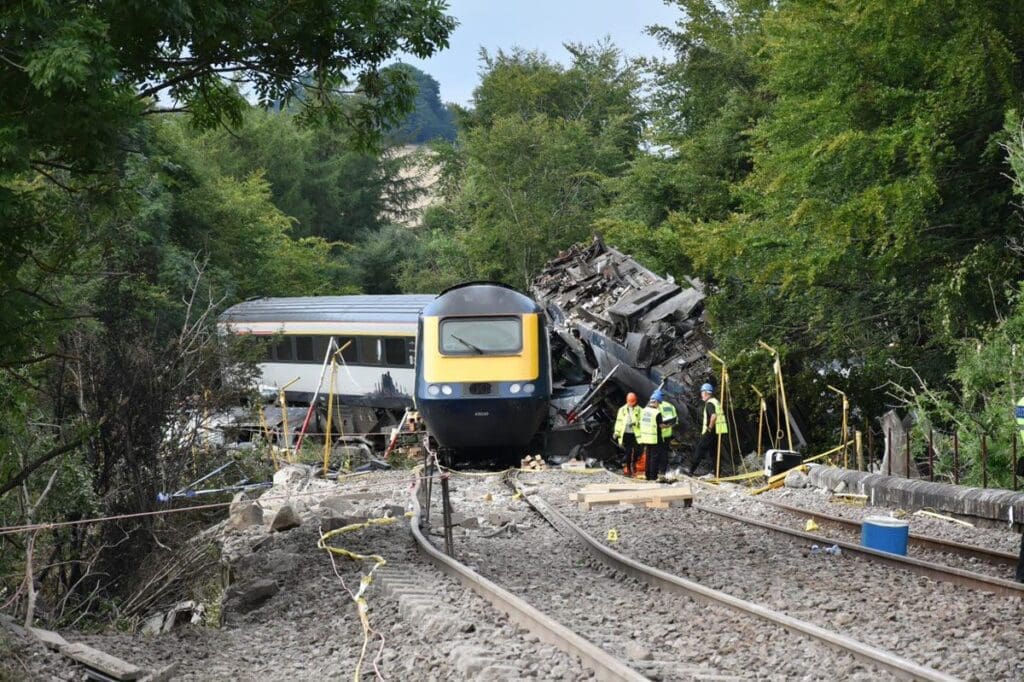
The Rail Accident Investigation Branch (RAIB) has released its report into the fatal derailment of a passenger train at Carmont, Aberdeenshire on August 12, 2020.
At around 09:37 hrs on Wednesday 12 August 2020, a passenger train derailed near Carmont, Aberdeenshire. The train, reporting number 1T08, was the 06:38 hrs service from Aberdeen to Glasgow, which was returning towards Aberdeen due to a blockage that had been reported on the line ahead.
It was travelling at 73 mph (117 km/h), just under the normal speed for the line concerned. After derailing, the train deviated to the left, before striking a bridge parapet which caused the vehicles to scatter. Tragically, three people died as a result of the accident: the conductor, Donald Dinnie; the train driver, Brett McCullough; a passenger, Christopher Stuchbury. The remaining six people on the train were injured.
Enjoy more Rail Express Magazine reading every month.
Click here to subscribe & save.
On the morning of the accident there was near-continuous heavy rain at the site of the accident between about 06:00 hrs and 09:00 hrs. The 51.5 mm of rain which fell in this period at the accident site was close to the average rainfall for the month of August in this part of Scotland. Train 1T08 derailed because it struck debris that had been washed out of a drainage trench. This trench, which had been constructed between 2011 and 2012, contained a perforated pipe that had been installed as part of a project to address a known problem with drainage and the stability of a cutting in that area. However, the drainage system and associated earthworks had not been constructed in accordance with the original design and so were not able to safely accommodate the water flows that morning.
RAIB’s investigators found that a low earth bank (bund) had been constructed that ran across a slope leading towards the track. The presence of this bund significantly altered the flow of water such that extreme rainfall would cause a concentrated flow into the steeply sloping section of trench. The evidence indicates that the intensity and duration of this rainfall would have generated water flows into the trench that were sufficient to wash away the gravel fill and the ground immediately surrounding the trench.
No instruction was given by route control or the signaller that train 1T08 should be run at a lower speed on its journey between Carmont and Stonehaven. At that time there was no written process that required any such precaution in these circumstances. Consequently, normal railway rules were applied to the train movement. The RAIB’s investigation found that the ‘route controllers’ (who were responsible for the operational management of Scotland’s railway network) had not been given the information, procedures or training that they needed to effectively manage complex situations of the type encountered on the morning of 12 August 2020.
The RAIB’s investigation also identified that Network Rail’s management processes had not identified or addressed weaknesses in the way it mitigated the consequences of extreme rainfall events. Furthermore, despite an awareness of the risk, Network Rail had not completed the implementation of additional control measures following previous events involving extreme weather and the management of operating incidents.
A train built to modern standards would have had a number of design features that are intended to minimise the damage to the train in case of collision or derailment.
However, the refurbished HST that derailed at Carmont was designed and constructed before some of these standards came into force. While it is not possible to be certain about what would have happened in the hypothetical situation with different rolling stock in the same accident, RAIB considers it more likely than not that the outcome would have been better if the train had been compliant with modern ‘crashworthiness’ standards.
What does RAIB recommend?
RAIB has made 20 recommendations for the improvement of railway safety. The areas covered include:
- Better management of civil engineering construction activities by Network Rail and its contractors additional standards and guidance on the safe design of drainage systems
- Improved operational response to extreme rainfall events, exploiting the full capability of modern technology, and based on a detailed understanding of the risk associated with extreme rainfall
- Enhancing the capability of route control offices to effectively manage complex events
- Extending Network Rail’s assurance regime to encompass route control offices addressing the obstacles to effective implementation of lessons learnt from the investigation of accidents and incidents
- Measures to prevent derailed trains from deviating too far from the track (equipment fitted to track and/or trains)
- Addressing train design issues identified by the investigation and better understanding the additional risk associated with the operation of older trains.
Simon French, the Chief Inspector of Rail Accidents, said: “This was a tragedy that devastated the lives of the three families who lost their loved ones and brought terror and injury to six other people on the morning of 12 August 2020. Our thoughts are with them all. Nothing can undo this event, but we owe it to everybody who was affected by it to strive to learn safety lessons for the future.
“Although railway safety in the UK has been steadily improving over recent decades, the tragedy at Carmont is a reminder of just how disruptive and potentially dangerous Britain’s volatile weather can be. The railway industry needs to get even smarter about the way it counters this threat, and to better exploit remarkable modern technology that enables the prediction and tracking of extreme weather events such as summer convective storms. There’s also an urgent need for the railway to provide real-time decision-makers with the information, procedures and training they need to manage complex and widespread weather-related events across the rail network.”




